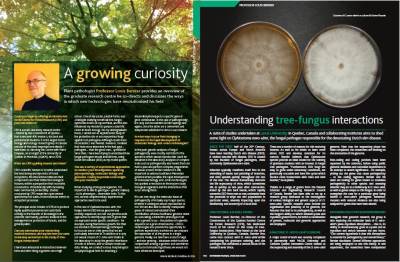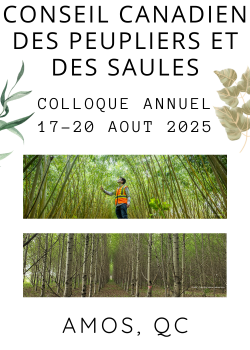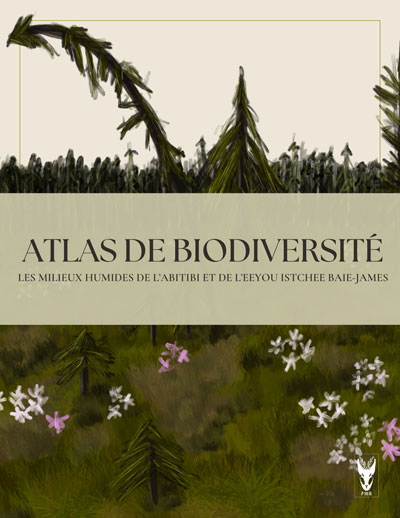
Louis Bernier
Regular member
Forest Pathology
Professeur à la retraite
Université Laval
Faculté de foresterie, de géographie et de géomatique
Département des sciences du bois et de la forêt
Pavillon Charles-Eugène Marchand, local 2263
1030 avenue de la Médecine
Québec (Québec) Canada, G1V 0A6
(418) 656-7655
WELCOME TO THE FOREST PATHOLOGY LABORATORY WEB PAGE

ACADEMIC BACKGROUND
- NSERC Postdoctoral Studies, Microbial genetics, 1989 (Université Laval)
- FCAR Postdoctoral Studies, Molecular biology of fungi, 1988-89 (University of Bath, UK)
- Ph.D. Forest pathology, 1989 (University of Toronto)
- M.Sc. Forest Sciences, 1983 (University of Toronto)
- B.Sc. Forest Sciences, 1981 (Université Laval)
Phytopathological News
2018
- Presentations and guest lectures: Louis Bernier was invited to present the team's work on Ophiostoma novo-ulmi in South Korea (Dankook University) and Sweden (Alnarp campus of the Swedish Agricultural University). He also presented at the International Congress of Plant Pathology(ICPP2018)
 in Boston, and at the LIFE+ ELMIAS Ash and Elm
in Boston, and at the LIFE+ ELMIAS Ash and Elm  conference in Sweden.
conference in Sweden.
Earlier during the year, Thais Campos de Oliveira and Jérôme Chapuis presented their work on the functional genomics of O. novo-ulmi at the 2018 Annual Meeting of CFR .
.
- New team members: Three persons joined the team so far this year. Undergraduate student Marie Bourgault investigates yeast-mycelium dimorphism in the Dutch elm disease fungi. Dr Jorge Luis Sarmiento Villamil is looking at the functional genomics of pathogenicity of DED fungi. Louis Paré started a Master's research project on endomycorrhizal fungi.
2017
- New graduate:In July, Martha Nigg successfully defended her PhD thesis on the transcriptomic analysis of yeast-mycelium dimorphism in Ophiostoma novo-ulmi. Martha is currently working on insect genomics at the French Institut de Recherche pour le Développement (IRD) in Gabon.
- Distinctions: Marine Vautier won the NSERC Science, Action!
 video contest. Have a look at her video
video contest. Have a look at her video  .
.
- The boss goes back to the bench!: I spent a sabbatical year with the research team of Philippe Silar
 at Université Paris Diderot (Paris 7) woring on the genetics of the ascomycete fungus Podospora anserina. This coprophilous species can complete its sexual cycle within 5-7 days in the laboratory and is amenable to targeted gene replacement. Thanks to efficient protocols used in Philippe's group, I was able to get KO mutants for several genes we had targeted.
at Université Paris Diderot (Paris 7) woring on the genetics of the ascomycete fungus Podospora anserina. This coprophilous species can complete its sexual cycle within 5-7 days in the laboratory and is amenable to targeted gene replacement. Thanks to efficient protocols used in Philippe's group, I was able to get KO mutants for several genes we had targeted.
- New team members: The boss may have been away for the year but life in the Forest Pathology and Fungal Genomics Laboratory did not stop, as several new members joined the team. Thais Campos de Oliveira and Jérôme Chapuis will both work on the functional genomics of Ophiostoma novo-ulmi. Grace Sumampong will be investigating populations of Heterobasidion causing root and butt rot of conifers, whereas Jean-Guy Catford will share his expertise in biochemistry and mycology with members of the team.
- New project: Thanks to funding from Genome Canada, Genome British Columbia and Génome Québec, the BioSurveillance of Alien Forest Enemies (BioSAFE) project has been launched. It will focus on selected forest invasive alien species including Ophiostoma novo-ulmi, causal agent of the current DED pandemic. You can learn more by visiting the BioSAFE website
 .
.
RESEARCH INTERESTS
Research carried out in my group focuses on the study of tree pathogenic fungi and fungal saprobes of wood and wood products. We use a variety of experimental approaches from the fields of phytopathology, molecular biology and genomics. Globally, members of my group work on the following topics:
- identification and characterization of microorganisms associated with poorly documented diseases;
- study of population structure and dynamics of pathogens;
- identification of genes contributing to pathogenicity and fitness.
RECENT RESEARCH ACTIVITIES
Over the years, we have investigated several species of tree pathogenic fungi, as well as saprobic fungi associated with either sapstain or decay. Here is a summary of ongoing research projects.
Identification of fungi associated with disease and decay of trees in Gabon and Cameroon
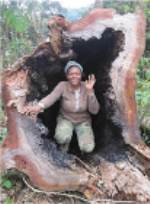
Within the context of a large-scale research and training project for countries in the Congo River basin, led by Prof. Damase Khasa at Université Laval (Projet d’appui à la formation en gestion des ressources naturelles dans le bassin du Congo ![]() ), we are studying fungi that cause disease or decay in tree species endemic in Central Africa. Ph.D. candidate Inès Nelly Moussavou Boussougou uses rDNA sequence data for identifying fungi that cause stem decay and root rot in three Gabonese tree species with a high commercial value, namely Desbordia glaucescens, Scyphocephalium ochocoa and Paraberlinia bifoliata. Joseph Djeugap Fovo, who successfully defended his Ph.D. thesis in June 2013, used the same approach and conducted Koch’s postulates for identifying fungal pathogens of Ricinodendron heudelotii, a species with strong potential for agroforestry in Cameroon. Drs Jean A. Bérubé (Canadian Forest service) and Daniel Dostaler (U. Laval, Dép. Phytologie) were close collaborators in these projects.
), we are studying fungi that cause disease or decay in tree species endemic in Central Africa. Ph.D. candidate Inès Nelly Moussavou Boussougou uses rDNA sequence data for identifying fungi that cause stem decay and root rot in three Gabonese tree species with a high commercial value, namely Desbordia glaucescens, Scyphocephalium ochocoa and Paraberlinia bifoliata. Joseph Djeugap Fovo, who successfully defended his Ph.D. thesis in June 2013, used the same approach and conducted Koch’s postulates for identifying fungal pathogens of Ricinodendron heudelotii, a species with strong potential for agroforestry in Cameroon. Drs Jean A. Bérubé (Canadian Forest service) and Daniel Dostaler (U. Laval, Dép. Phytologie) were close collaborators in these projects.
Study of fungal pathogens of hybrid poplars
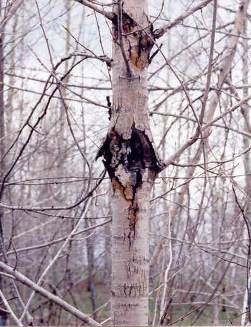
Photo: Patrick Filiatrault
Due to their rapid growth under local climatic conditions, hybrid poplars are a promising source of fiber for the North American forest industry, including companies in Quebec (more info at Réseau intégré Ligniculture-Québec ![]() ). Tree breeders at the Quebec Ministry of Natural Resources have already produced a comprehensive collection of hybrid poplar clones that are adapted to different bioclamitic zones within the province. This material is also bred for resistance against diseases, notably Septoria canker caused by the ascomycete fungus Mycosphaerella populorum, and poplar leaf rust cause by basidiomycete fungi belonging to the genus Melampsora. In order to achieve durable resistance, it is important to identify factors that govern pathogenicity and virulence in the fungi, and resistance in their hosts.
Lauriane Varain, who obtained her Master’s degree in June 2013, worked on the development of an Agrobacterium tumefaciens-based system for the genetic transformation of M. populorum. The ultimate goal of the project is to facilitate the production of mutants that will help investigate the molecular bases of pathogenicity and virulence in M. populorum. Ph. D. candidate Marine Vautier is using genomic and transcriptomic approaches for investigating defense mechanisms of hybrid poplar against M. populorum and Melampsora spp. These collaborative studies are conducted in the laboratories of Drs. Philippe Tanguay and Armand Séguin at the Canadian Forest Service.
). Tree breeders at the Quebec Ministry of Natural Resources have already produced a comprehensive collection of hybrid poplar clones that are adapted to different bioclamitic zones within the province. This material is also bred for resistance against diseases, notably Septoria canker caused by the ascomycete fungus Mycosphaerella populorum, and poplar leaf rust cause by basidiomycete fungi belonging to the genus Melampsora. In order to achieve durable resistance, it is important to identify factors that govern pathogenicity and virulence in the fungi, and resistance in their hosts.
Lauriane Varain, who obtained her Master’s degree in June 2013, worked on the development of an Agrobacterium tumefaciens-based system for the genetic transformation of M. populorum. The ultimate goal of the project is to facilitate the production of mutants that will help investigate the molecular bases of pathogenicity and virulence in M. populorum. Ph. D. candidate Marine Vautier is using genomic and transcriptomic approaches for investigating defense mechanisms of hybrid poplar against M. populorum and Melampsora spp. These collaborative studies are conducted in the laboratories of Drs. Philippe Tanguay and Armand Séguin at the Canadian Forest Service.
Genomics of the Dutch elm disease fungi
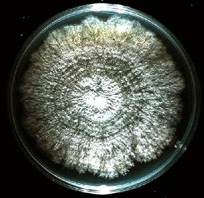
Elm populations in Europe and North America were decimated by two successive pandemics of Dutch elm disease (DED). The more recent pandemic, caused by the ascomycete fungus Ophiostoma novo-ulmi, has killed an estimated 1 billion trees. While the DED cycle is well known (the pathogen invades xylem vessels after it has been introduced into healthy trees by elm bark beetles), the actual mechanisms by which O. novo-ulmi kills its host remain unknown. The identification of factors contributing to parasitic fitness (including pathogenicity) is important for the development of long-term control strategies against DED. We use a combination of genetic, molecular and genome-wide approaches in our investigations of the 8640 genes annotated in the O. novo-ulmi genome ![]() . Ongoing work includes identification of genes that modulate pathogenicity, as well as the molecular bases of yeast-mycelium dimorphism in O. novo-ulmi, in order to test the hypothesis that the transition between these two growth forms contributes to parasitic fitness. Studies by members of the team should provide new insight on this aspect of O. novo-ulmi biology.
. Ongoing work includes identification of genes that modulate pathogenicity, as well as the molecular bases of yeast-mycelium dimorphism in O. novo-ulmi, in order to test the hypothesis that the transition between these two growth forms contributes to parasitic fitness. Studies by members of the team should provide new insight on this aspect of O. novo-ulmi biology.
We are actively involved in the BioSAFE ![]() project and are also collaborating with colleagues at the University of Guelph and the Universidad Politécnica de Madrid in studies of the response to infection by O. novo-ulmi.
project and are also collaborating with colleagues at the University of Guelph and the Universidad Politécnica de Madrid in studies of the response to infection by O. novo-ulmi.
TEAM MEMBERS, 2010-2013
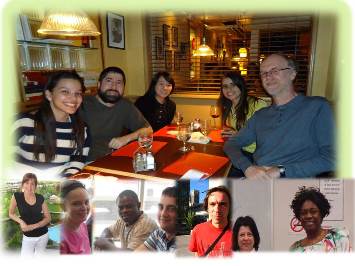
Montage photo: Erika Sayuri Naruzawa
AWARDS
- 2002 Gordon J. Green Outstanding Young Scientist Award, Canadian Society of Plant Pathology
- 2008 Hommage René-Pomerleau "Pionnier et Force vive de la pathologie forestière et moléculaire", Quebec Society for the Protection of Plants
You can download all my bibliography in the BibTeX, BibTeX-CSV, FRQNT or EndNote format
PUBLICATIONS
Books
None
Book chapters
- Bernier, L. (2022) Dutch elm disease. (Chap. 25) In Forest Microbiology: Volume 2: Forest Tree Health. (Asiegbu, F. and A. Kovalchuk, Eds.) Elsevier, pages 291-309
- Bernier, L., Smith, S.M. (2015) Pests and Pathogens in North American Forest Ecosystems. (Chap. 16) In Routledge Handbook of Forest Ecology. (Peh, K.S.-H., Corlett, R.T. and Bergeron, Y., Eds.) Routledge, Oxford, UK
- Bernier, L. (2013) Towards Ophiostoma Genomics (Chap. 21). In CBS Biodiversity Series 12. The Ophiostomatoid Fungi: Expanding Frontiers. (Seifert, K.A., de Beer, Z.W. and Wingfield, M.J., Eds.) Utrecht, pages 235-242
- Massoumi Alamouti, S., Beaulieu, M.-E., Bernier, L., Breuil, C. (2013) Ophiostomatoid associates of spruce-infesting bark beetles in North America (Chap. 10). In CBS Biodiversity Series 12. The Ophiostomatoid Fungi: Expanding Frontiers. (Seifert, K.A., de Beer, Z.W. and & Wingfield, M.J., Eds.) Utrecht, pages 119-130
- Dewar, K., Bernier, L., Levesque, R.C. (1996) Electrophoretic karyotyping in fungi. (Chap. 2) In Nonmammalian Genomic Analysis: A Practical Guide. (Birren, B. and Lai, E., Eds.) San Diego, CA, USA, Academic Press, pages 25-60
- Bernier, L. (1993) Conventional and molecular genetic approaches to the study of pathogenicity in Ophiostoma ulmi sensu lato. (Chap. 22) In Dutch Elm Disease Research: Cellular and Molecular Approaches. (Sticklen, M.B. and Sherald, J.L., Eds.) New-York, USA, Springer-Verlag, pages 293-307
Edited books, special journal editions and proceedings
None
Peer-reviewed articles
- de Oliveira, T.C., Freyria, N.J., Sarmiento-Villamil, J.L., Porth, I., Tanguay, P., Bernier, L. (2024) Unraveling the transcriptional features and gene expression networks of pathogenic and saprotrophic Ophiostoma species during the infection of Ulmus americana. Microbiology Spectrum
- Moslehi, M., Bernier, L., Zakeri, O., Ahmadi, A. (2024) First report of Streblote solitaria (Lepidoptera: Lasiocampidae) damage on Avicennia marina trees in southern mangroves of Iran. Ecological Frontiers, 44(2):359-364
- Sumampong, G., Feau, N., Bernier, L., Hamelin, R.C., Liu, J.-J., Shamoun, S.F. (2024) Genome sequence of Heterobasidion occidentale, a fungus that causes annosus root and butt rot among conifer trees in North America. Microbiology Resource Announcements
- Tanguay, P., Benoit, N., Potvin, A., Bernier, L. (2024) Development of a qPCR Assay for the Detection and Quantification of the Fungal Pathogen Calonectria canadiana on Conifers. Forest Pathology, 54(5):e12885
- Fijarczyk, A., Bernier, L., Sakalidis, M.L., Medina-Mora, C.M., Porth, I. (2023) Independent Evolution Has Led to Distinct Genomic Signatures in Dutch Elm Disease-Causing Fungi and Other Vascular Wilts-Causing Fungal Pathogens. Journal of Fungi, 9
- Martin, J.A., Dominguez, J., Solla, A., Brasier, C.M., Webber, J.F., Santini, A., Martinez-Arias, C., Bernier, L., Gil, L. (2023) Complexities underlying the breeding and deployment of Dutch elm disease resistant elms. New Forests, 54(4):661 – 696
- Islam, M.T., Coutin, J.F., Shukla, M., Dhaliwal, A.K., Nigg, M., Bernier, L., Sherif, S.M., Saxena, P.K. (2022) Deciphering the Genome-Wide Transcriptomic Changes during Interactions of Resistant and Susceptible Genotypes of American Elm with Ophiostoma novo-ulmi. Journal of Fungi, 8(2)
- Nigg, M., de Oliveira, T.C., Sarmiento-Villamil, J.L., de la Bastide, P.Y., Hintz, W.E., Sherif, S.M., Shukla, M., Bernier, L., Saxena, P.K. (2022) Comparative Analysis of Transcriptomes of Ophiostoma novo-ulmi ssp. americana Colonizing Resistant or Sensitive Genotypes of American Elm. Journal of Fungi, 8(6)
- Pare, L., Banchini, C., Hamel, C., Bernier, L., Stefani, F. (2022) A simple and low-cost technique to initiate single-spore cultures of arbuscular mycorrhizal fungi using a superabsorbent polymer. Symbiosis
- Pare, L., Banchini, C., Hamel, C., Bernier, L., Stefani, F. (2022) Correction: A simple and low-cost technique to initiate single-spore cultures of arbuscular mycorrhizal fungi using a superabsorbent polymer (Symbiosis, (2022), 88, 1-3, (61-73), 10.1007/s13199-022-00878-5). Symbiosis, 88(1-3):79
- Sarmiento-Villamil, J.L., Campos de Oliveira, T., Naruzawa, E.S., Bernier, L. (2021) An Efficient Strategy for Obtaining Mutants by Targeted Gene Deletion in Ophiostoma novo-ulmi. Frontiers in Microbiology, 12:1933
- Martin, J.A., Dominguez, J., Solla, A., Brasier, C.M., Webber, J.F., Santini, A., Martinez-Arias, C., Bernier, L., Gil, L. (2021) Complexities underlying the breeding and deployment of Dutch elm disease resistant elms. New Forests
- Hessenauer, P., Fijarczyk, A., Martin, H., Prunier, J., Charron, G., Chapuis, J., Bernier, L., Tanguay, P., Hamelin, R.C., Landry, C.R. (2020) Hybridization and introgression drive genome evolution of Dutch elm disease pathogens. Nature Ecology & Evolution
- DesRochers, P., Nadeau-Thibodeau, N., Bernier, L., Rioux, D. (2020) Reaction to release treatments and distinctive attributes of butternut that promote resistance to the canker caused by Ophiognomonia clavigignenti-juglandacearum. Forestry Chronicle, 96(02):130-140
- Et-Touil, A., Dusabenyagasani, M., Bouvet, G., Brasier, C., Bernier, L. (2019) Ophiostoma ulmi DNA naturally introgressed into an isolate of Ophiostoma novo-ulmi is clustered around pathogenicity and mating type loci. Phytoprotection, 99(1):1-11
- Rioux, D., Blais, M., Nadeau-Thibodeau, N., Lagace, M., DesRochers, P., Klimaszewska, K., Bernier, L. (2018) First Extensive Microscopic Study of Butternut Defense Mechanisms Following Inoculation with the Canker Pathogen Ophiognomonia clavigignenti-juglandacearum Reveals Compartmentalization of Tissue Damage. Phytopathology, 108(11):1237-1252
- Nigg, M., Bernier, L. (2017) Large-scale genomic analyses of in vitro yeast-mycelium dimorphism in human, insect and plant pathogenic fungi: From ESTs to RNAseq experiments. Fungal Biology Reviews, 31(3):131 - 142
- Djeugap Fovo, J., Dostaler, D., Bernier, L. (2017) Influence of Culture Media and Temperature on Growth and Sporulation of Lasiodiplodia theobromae, Pestalotiopsis microspora and Fusarium oxysporum Isolated from Ricinodendron heudelotii in Cameroon. International Journal of Current Microbiology and Applied Sciences, 6(6):3098-3112
- Naruzawa, E.S., Malagnac, F., Bernier, L. (2016) Effect of linoleic acid on reproduction and yeast–mycelium dimorphism in the Dutch elm disease pathogens. Botany, 94(1):31-39
- Sherif, S. M., Shukla, M. R., Murch, S. J., Bernier, L., Saxena, P. K. (2016) Simultaneous induction of jasmonic acid and disease-responsive genes signifies tolerance of American elm to Dutch elm disease. Scientific Reports, 6:21934-
- Djeugap, F.J, Bernier, L., Dostaler, D., Zena, D.R.G. (2016) First report of Lasiodiplodia theobromae causing shoot blight of Ricinodendron heudelotii seedlings in Cameroon. International Journal of Agronomy and Agricultural Research, 8:59-63
- Wedge, M.-E., Naruzawa, E.S., Nigg, M., Bernier, L. (2016) Diversity in yeast-mycelium dimorphism response of the dutch elm disease pathogens: The inoculum size effect. Canadian Journal of Microbiology, 62(6):525-529
- Bernier, L. (2016) Genome-wide analysis of parasitic fitness traits in a non-model tree pathogen. Canadian Journal of Plant Pathology, 38(2):153-163
- Comeau, A.M., Vincent, W.F., Bernier, L., Lovejoy, C. (2016) Novel chytrid lineages dominate fungal sequences in diverse marine and freshwater habitats. Scientific Reports, 6:30120-
- Nigg, M., Bernier, L. (2016) From yeast to hypha: defining transcriptomic signatures of the morphological switch in the dimorphic fungal pathogen Ophiostoma novo-ulmi. BMC Genomics, 17(1):920
- Bernier, L., Aoun, M., Bouvet, G.F., Comeau, A.M., Dufour, J., Naruzawa, E.S., Nigg, M., Plourde K.V. (2015) Genomics of the Dutch elm disease pathosystem: are we there yet? iForest - Biogeosciences and Forestry, 8(2):149-157
- Comeau, A.M., Dufour, J., Bouvet, G.F., Jacobi, V., Nigg, M., Henrissat, B., Laroche, J., Levesque, R.C., Bernier, L. (2015) Functional Annotation of the Ophiostoma novo-ulmi Genome: Insights into the Phytopathogenicity of the Fungal Agent of Dutch Elm Disease. Genome Biology and Evolution, 7(2):410-430
- Dhillon, B., Feau, N., Aerts, A.L., Beauseigle, S., Bernier, L., Copeland, A., Foster, A., Gill, N., Henrissat, B., Herath, P. et al. (2015) Horizontal gene transfer and gene dosage drives adaptation to wood colonization in a tree pathogen. Proceedings of the National Academy of Sciences of the United States of America, 112(11):3451-3456
- Nigg, M., Laroche, J., Landry, C.R., Bernier, L. (2015) RNAseq Analysis Highlights Specific Transcriptome Signatures of Yeast and Mycelial Growth Phases in the Dutch Elm Disease Fungus Ophiostoma novo-ulmi. G3: Genes|Genomes|Genetics, 5(11):2487-2495
- Djeugap, F.J., Bernier, L., Dostaler, D., Zena, D.R.G. (2015) Chemical Control of Shoot Blight [Lasiodiplodia theobromae (Pat.) Griffon & Maubl.] Infecting Ricinodendron heudelotii Seedlings in Cameroon. International Journal of Current Research in Biosciences and Plant Biology, 2:82-87
- Plourde, K.V., Bernier, L. (2014) A rapid virulence assay for the Dutch elm disease fungus Ophiostoma novo-ulmi by inoculation of apple (Malus × domestica ‘Golden Delicious’) fruits. Plant Pathology, 63(5):1078-1085
- Naruzawa, E.S., Bernier, L. (2014) Control of yeast-mycelium dimorphism in vitro in Dutch elm disease fungi by manipulation of specific external stimuli. Fungal Biology, 118(11):872 - 884
- Djeugap, F.J., Bernier, L., Dostaler, D., Fontem, D.A., Avana, M.L. (2014) Germination constraints on Ricinodendron heudelotii in Cameroon. Seed Technology, 36:61-72
- Vialle, A., Feau, N., Frey, P., Bernier, L., Hamelin, R.C. (2013) Phylogenetic species recognition reveals host-specific lineages among poplar rust fungi. Molecular Phylogenetics and Evolution, 66(3):628-644
- Forgetta, V., Leveque, G., Dias, J., Grove, D., Lyons Jr., R., Genik, S., Wright, C., Singh, S., Peterson, N., Zianni, M. et al. (2013) Sequencing of the Dutch Elm Disease Fungus Genome Using the Roche/454 GS-FLX Titanium System in a Comparison of Multiple Genomics Core Facilities. Journal of Biomolecular Techniques, 24(2):39-49
- Djeugap Fovo, J., Bernier, L., Dostaler, D., Khasa, D.P., Fontem, D.A., Nwaga, D. (2013) Opportunités et contraintes agroforestières de Ricinodendron heudelotii au Cameroun. International Journal of Biological and Chemical Sciences, 7:344-355
- Cacas, J.-L., Petitot, A.-S., Bernier, L., Estevan, J., Conejero, G., Mongrand, S., Fernandez, D. (2011) Identification and characterization of the Non-race specific Disease Resistance 1 (NDR1) orthologous protein in coffee. BMC Plant Biology, 11(1):144
- Hintz, W., Pinchback, M., de la Bastide, P., Burgess, S., Jacobi, V., Hamelin, R., Breuil, C., Bernier, L. (2011) Functional categorization of unique expressed sequence tags obtained from the yeast-like growth phase of the elm pathogen Ophiostoma novo-ulmi. BMC Genomics, 12(1):431
- Vialle, A., Frey, P., Hambleton, S., Bernier, L., Hamelin, R. (2011) Poplar rust systematics and refinement of Melampsora species delineation. Fungal Diversity, 50(1):227-248
- Jacobi, V., Dufour, J., Bouvet, G.F., Aoun, M., Bernier, L. (2010) Identification of transcripts up-regulated in asexual and sexual fruiting bodies of the Dutch elm disease pathogen Ophiostoma novo-ulmi. Canadian Journal of Microbiology, 56(8):697-705
- Aoun, M., Jacobi, V., Boyle, B., Bernier, L. (2010) Identification and monitoring of Ulmus americana transcripts during in vitro interactions with the Dutch elm disease pathogen Ophiostoma novo-ulmi. Physiological and Molecular Plant Pathology, 74(3-4):254-266
- Feau, N., Mottet, M.-J., Perinet, P., Hamelin, R.C., Bernier, L. (2010) Recent advances related to poplar leaf spot and canker caused by Septoria musiva. Canadian Journal of Plant Pathology, 32(2):122-134
- Aoun, M., Rioux, D., Simard, M., Bernier, L. (2009) Fungal Colonization and Host Defense Reactions in Ulmus americana Callus Cultures Inoculated with Ophiostoma novo-ulmi. Phytopathology, 99(6):642-650
- Temple, B., Bernier, L., Hintz, W.E. (2009) Characterisation of the polygalacturonase gene of the Dutch elm disease pathogen Ophiostoma novo-ulmi. New Zealand Journal of Forestry Science, 39(1):29-37
- Germain, H., Bergeron, M.-J., Bernier, L., Laflamme, G., Hamelin, R.C. (2009) Patterns of colonization and spread in the fungal spruce pathogen Onnia tomentosa. Molecular Ecology, 18(21):4422-4433
- LeBoldus, J.M., Blenis, P.V., Thomas, B.R., Feau, N., Bernier, L. (2009) Susceptibility of Populus balsamifera to Septoria musiva: A Field Study and Greenhouse Experiment. Plant Disease, 93(11):1146-1150
- Stanosz, G., Smith, D., Bernier, L. (2009) First report of Erysiphe palczewskii powdery mildew of Siberian pea tree (Caranga arborescens) in Wisconsin and Quebec. Plant Disease, 93(12):1352
- Bouvet, G.F., Jacobi, V., Plourde, K.V., Bernier, L. (2008) Stress-induced mobility of OPHIO1 and OPHIO2, DNA transposons of the Dutch elm disease fungi. Fungal Genetics and Biology, 45(4):565-578
- Plourde, K., Jacobi, V., Bernier, L. (2008) Use of insertional mutagenesis to tag putative parasitic fitness genes in the Dutch elm disease fungus Ophiostoma novo-ulmi subsp. novo-ulmi. Canadian Journal of Microbiology, 54(9):797-802
- Morin, C., Couturier, S., Bernier, L. (2007) Pathogenicity of wild-type and albino strains of the fungus Ceratocystis resinifera, a potential biocontrol agent against bluestain. Canadian Journal of Forest Research, 37(5):919-930
- Bouvet, G.F., Jacobi, V., Bernier, L. (2007) Characterization of three DNA transposons in the Dutch elm disease fungi and evidence of repeat-induced point (RIP) mutations. Fungal Genetics and Biology, 44(5):430-443
- Feau, N., Hamelin, R., Bernier, L. (2007) Variability of Nuclear SSU-rDNA Group Introns Within Septoria Species: Incongruence with Host Sequence Phylogenies. Journal of Molecular Evolution, 64(5):489-499
- Vujanovic, V., Hamelin, R. C., Bernier, L., Vujanovic, G., St-Arnaud, M. (2007) Fungal diversity, dominance, and community structure in the rhizosphere of clonal Picea mariana plants throughout nursery production chronosequences. Microbial Ecology, 54(4):672-684
- Bourassa, M., Bernier, L., Hamelin, R.C. (2007) Genetic Diversity in Poplar Leaf Rust (Melampsora medusae f. sp. deltoidae) in the Zones of Host Sympatry and Allopatry. Phytopathology, 97(5):603-610
- Tanguay, P., Loppnau, P., Morin, C., Bernier, L., Breuil, C. (2006) A spontaneous albino mutant of Ceratocystis resinifera results from a point mutation in the polyketide synthase gene, PKS1. Canadian Journal of Microbiology, 52(6):501-507
- Feau, N., Jacobi, V., Hamelin, R.C., Bernier, L. (2006) Screening of ESTs from Septoria musiva (teleomorph Mycosphaerella populorum) for detection of SSR and PCR-RFLP markers. Molecular Ecology Notes, 6(2):356-358
- Feau, N., Hamelin, R.C., Bernier, L. (2006) Attributes and congruence of three molecular data sets: Inferring phylogenies among Septoria-related species from woody perennial plants. Molecular Phylogenetics and Evolution, 40(3):808-829
- Morin, C., Tanguay, P., Breuil, C., Yang, D.Q., Bernier, L. (2006) Bioprotection of spruce logs against sapstain using an albino strain of Ceratocystis resinifera. Phytopathology, 96(5):526-533
- Et-Touil, A., Rioux, D., Mathieu, F.M., Bernier, L. (2005) External symptoms and histopathological changes following inoculation of elms putatively resistant to Dutch elm disease with genetically close strains of Ophiostoma. Canadian Journal of Botany, 83(6):656-667
- Bourassa, M., Bernier, L., Hamelin, R.C. (2005) Direct genotyping of the poplar leaf rust fungus, Melampsora medusae f. sp deltoidae, using codominant PCR-SSCP markers. Forest Pathology, 35(4):245-261
- Feau, N., Weiland, J.E., Stanosz, G.R., Bernier, L. (2005) Specific and sensitive PCR-based detection of Septoria musiva, S-populicola and S-populi, the causes of leaf spot and stem canker on poplars. Mycological Research, 109:1015-1028
- Feau, N., Hamelin, R.C., Vandecasteele, C., Stanosz, G.R., Bernier, L. (2005) Genetic structure of Mycosphaerella populoram (Anamorph Septoria musiva) Populations in north-central and northeastern north America. Phytopathology, 95(6):608-616
- Ouellette, G.B., Cherif, M., Simard, M., Bernier, L. (2005) Histopathology of Fusarium wilt of staghorn sumac (Rhus typhina) caused by Fusarium oxysporum f. s.p. callistephi race 3. I. Modes of tissue colonization and pathogen peculiarities. Phytoprotection, 86(3):157-174
- Filion, M., Hamelin, R.C., Bernier, L., St-Arnaud, M. (2004) Molecular profiling of rhizosphere microbial communities associated with healthy and diseased black spruce (Picea mariana) seedlings grown in a nursery. Applied and Environmental Microbiology, 70(6):3541-3551
- Morin, C., Breuil, C., Bernier, L. (2004) Genetic variability and structure of Canadian populations of the sapstain fungus Ceratocystis resinifera. Phytopathology, 94(12):1323-1330
- Bernier, L. (2004) Genomics of ophiostomatoid fungi: the first two thousand genes. Phytoprotection, 85(1):39-43
- Feau, N., Bernier, L. (2004) First report of shining willow as a host plant for Septoria musiva. Plant Disease, 88(7):770-770
- Gargouri, S., Bernier, L., Hajlaoui, M.R., Marrakchi, M. (2003) Genetic variability and population structure of the wheat foot rot fungus, Fusarium culmorum, in Tunisia. European Journal of Plant Pathology, 109(8):807-815
- Tanguay, P., Coupal, J., Bernier, L. (2003) Genetic transformation, electrophoretic karyotyping and isolation of insertional mutants in the tree pathogenic fungus Neonectria galligena. Forest Pathology, 33(6):413-428
- Tadesse, Y., Bernier, L., Hintz, W.E., Horgen, P.A. (2003) Real time RT-PCR quantification and Northern analysis of cerato-ulmin (CU) gene transcription in different strains of the phytopathogens Ophiostoma ulmi and O. novo-ulmi. Molecular Genetics and Genomics, 269(6):789-796
- Germain, H., Laflamme, G., Bernier, L., Boulet, B., Hamelin, R.C. (2002) DNA polymorphism and molecular diagnosis in Inonotus spp. Canadian Journal of Plant Pathology, 24(2):194-199
- Reyes, I., Bernier, L., Antoun, H. (2002) Rock phosphate solubilization and colonization of maize rhizosphere by wild and genetically modified strains of Penicillium rugulosum. Microbial Ecology, 44(1):39-48
- Plante, F., Hamelin, R.C., Bernier, L. (2002) A comparative study of genetic diversity of populations of Nectria galligena and N-coccinea var. faginata in North America. Mycological Research, 106:183-193
- Kabore, B.K., Couture, L., Dostaler, D., Bernier, L. (2001) Variabilité phénétique du Colletotrichum graminicola du sorgho. Canadian Journal of Plant Pathology, 23(2):138-145
- Cheng, Y., Belzile, F., Tanguay, P., Bernier, L., Belanger, R. (2001) Establishment of a gene transfer system for Pseudozyma flocculosa, an antagonistic fungus of powdery mildew fungi. Molecular Genetics and Genomics, V266(1):96-102
- Gagne, P., Yang, D.Q., Hamelin, R.C., Bernier, L. (2001) Genetic Variability of Canadian Populations of the Sapstain Fungus Ophiostoma piceae. Phytopathology, 91(4):369-376
- Reyes, I., Baziramakenga, R., Bernier, L., Antoun, H. (2001) Solubilization of phosphate rocks and minerals by a wild-type strain and two UV-induced mutants of Penicillium rugulosum. Soil Biology and Biochemistry, 33(12-13):1741-1747
- Ouellette, G.B., Rioux, D., Bussieres, G., Simard, M., Bernier, L. (2000) Extracellular sheath formation by Sphaeropsis hypodermia and association with its infection in elm trees. Phytoprotection, 81(2):69-86
- Gosselin, L., Jobidon, R., Bernier, L. (1999) Biological Control of Stump Sprouting of Broadleaf Species in Rights-of-Way with Chondrostereum purpureum: Incidence of the Disease on Nontarget Hosts. Biological Control, 16:60-67
- Uzunovic, A., Yang, D.Q., Gagne, P., Breuil, C., Bernier, L., Byrne, A., Gignac, M., Kim, S.H. (1999) Fungi that cause sapstain in Canadian softwoods. Canadian Journal of Microbiology, 45:914–922
- Reyes, I., Bernier, L., Simard, R.R., Tanguay, P., Antoun, H. (1999) Characteristics of phosphate solubilization by an isolate of a tropical Penicillium rugulosum and two UV-induced mutants. FEMS Microbiology Ecology, 28(3):291-295
- Reyes, I., Bernier, L., Simard, R.R., Antoun, H. (1999) Effect of nitrogen source on the solubilization of different inorganic phosphates by an isolate of Penicillium rugulosum and two UV-induced mutants. FEMS Microbiology Ecology, 28(3):281-290
- Yang, D.Q., Gagne, P., Uzunovic, A., Gignac, M., Bernier, L. (1999) Development of fungal stain in logs of three Canadian softwoods. Forest Products Journal, 49(2):39-42
- Gosselin, L., Jobidon, R., Bernier, L. (1999) Genetic variability and structure of Canadian populations of Chondrostereum purpureum, a potential biophytocide. Molecular Ecology, 8(1):113-122
- Et-Touil, A., Brasier, C.M., Bernier, L. (1999) Localization of a pathogenicity gene in Ophiostoma novo-ulmi and evidence that it may be introgressed from O-ulmi. Molecular Plant-Microbe Interactions, 12(1):6-15
- Et-touil, K., Bernier, L., Beaulieu, J., Berube, J.A., Hopkin, A., Hamelin, R.C. (1999) Genetic Structure of Cronartium ribicola Populations in Eastern Canada. Phytopathology, 89(10):915-919
- Dewar, K., Bousquet, J., Dufour, J., Bernier, L. (1997) A meiotically reproducible chromosome length polymorphism in the ascomycete fungus Ophiostoma ulmi (sensu lato). Molecular and General Genetics, 255(1):38-44
- Plante, F., Bernier, L. (1997) Variability of virulence of Nectria galligena towards northern hardwoods. European Journal of Forest Pathology, 27(4):261-272
- Temple, B., Horgen, P.A., Bernier, L., Hintz, W.E. (1997) Cerato-ulmin, a hydrophobin secreted by the causal agents of Dutch elm disease, is a parasitic fitness factor. Fungal Genetics and Biology, 22(1):39-53
- Gosselin, L., Jobidon, R., Bernier, L. (1996) Assessment of genetic variation within Chondrostereum purpureum from Quebec by random amplified polymorphic DNA analysis. Mycological Research, 100:151-158
- Yang, D.Q., Bernier, L. (1996) Production and use of calli from yellow birch buds for in vitro assessment of virulence of Nectria galligena isolates. Plant Cell, Tissue and Organ Culture, 45(2):175-177
- Bernier, L., Yang, D., Ouellette, G.B., Dessureault, M. (1996) Assessment of Phaeotheca dimorphospora for biological control of the Dutch elm disease pathogens, Ophiostoma ulmi and O. novo-ulmi doi:10.1046/j.1365-3059.1996.d01-161.x. Plant Pathology, 45(4):609-617
- Yang, D.Q., Bernier, L., Dessureault, M. (1995) Phaeotheca dimorphospora increases Trichoderma harzianum density in soil and suppresses red pine damping-off caused by Cylindrocladium scoparium. Canadian Journal of Botany, 73(5):693-700
- Yang, D.Q., Laflamme, G., Bernier, L., Dessureault, M. (1995) Phaeotheca dimorphospora as a potential biocontrol agent for shoot blight caused by Gremmeniella abietina. Canadian Journal of Plant Pathology, 17(1):7-12
- Dewar, K., Bernier, L. (1995) Inheritance of chromosome-length polymorphisms in Ophiostoma ulmi (sensu lato). Current Genetics, 27(6):541-549
- Bernier, L., Hamelin, R.C., Ouellette, G.B. (1994) Comparison of ribosomal DNA length and restriction site polymorphisms in Gremmeniella and Ascocalyx isolates. Applied and Environmental Microbiology, 60(4):1279-1286
- Bernier, L., Hubbes, M. (1994) Induction and genetic characterization of ultraviolet-sensitive mutants in the elm tree pathogen Ophiostoma ulmi(sensu lato). Mycological Research, 98:943-953
- Yang, D.Q., Bernier, L., Dessureault, M. (1994) Biological control of Septoria leaf spot of poplar by Phaeotheca dimorphospora. Plant Disease, 78(8):821-825
- Yang, D.Q., Plante, F., Bernier, L., Piche, Y., Dessureault, M., Laflamme, G., Ouellette, G.B. (1993) Evaluation of a Fungal Antagonist, Phaeotheca-Dimorphospora, for Biological-Control of Tree Diseases. Canadian Journal of Botany, 71(3):426-433
- Dewar, K., Bernier, L. (1993) Electrophoretic karyotypes of the elm tree pathogen Ophiostoma ulmi (sensu lato). Molecular Genetics and Genomics, 238(1):43-48
- Hamelin, R.C., Ouellette, G.B., Bernier, L. (1993) Identification of Gremmeniella abietina Races with Random Amplified Polymorphic DNA Markers. Applied and Environmental Microbiology, 59(6):1752-1755
- Bernier, L., Hubbes, M. (1990) Mutations in Ophiostoma ulmi induced by N-methyl-N'-nitro-N-nitrosoguanidine. Canadian Journal of Botany, 68(2):225-231
- Bernier, L., Hubbes, M. (1990) Meiotic analysis of induced mutations in Ophiostoma ulmi. Canadian Journal of Botany, 68(2):232-235
- Bernier, L., Cooper, R.M., Charnley, A.K., Clarkson, J.M. (1989) Transformation of the entomopathogenic fungus Metarhizium anisopliae to benomyl resistance doi:10.1111/j.1574-6968.1989.tb03483.x. FEMS Microbiology Letters, 60(3):261-266
- Jeng, R.S., Bernier, L., Brasier, C.M. (1988) A comparative study of cultural and electrophoretic characteristics of the Eurasian and North American races of Ophiostoma ulmi. Canadian Journal of Botany, 66(7):1325-1333
- Bernier, L., Jeng, R.S., Hubbes, M. (1983) Differentiation of aggressive and non-aggressive strains of Ceratocystis ulmi by polyacrylamide gel electrophoresis of intramycelial enzymes. Mycotaxon, 17:456–72
Articles published in proceedings
- Villamil, J.L.S., Campos de Oliveira, T., Naruzawa, E. S., Bernier, L. (2019) An efficient strategy for obtaining mutants by targeted gene deletion in Ophiostoma novo-ulmi. In Molecular Plant-Microbe Interactions. 3340 Pilot Knob Road, St Paul, MN 55121 USA, October. Amer Phytopathological Soc, page 120
- Bernier, L. (2017) Genome-wide analyses of the Dutch elm disease fungi. In Proceedings of the American elm restoration workshop 2016: 2016 October 25-27. Lewis Center, OH. Gen. Tech. Rep. NRS-P-174. Newtown Square, PA. (Knight, Kathleen S.; Haugen, Linda M.; Flower, Charles E.; Slavicek, James M., Eds.) Pages 6-20
- Tsui, C.K.M., Alamouti, S.M., Bernier, L., Bohlmann, J., Breuil, C., Hamelin, R.C. (2009) Population structure of Grosmannia clavigera, a pine pathogen associated with mountain pine beetle. In Canadian Journal of Plant Pathology. January. Canadian Phytopathological Soc, pages 139-139
- Aoun, M., Jacobi, V., Boyle, B., Rioux, D., Simard, M., Bernier, L. (2009) Identification and profiling of American elm genes involved in a compatible interaction with the fungal pathogen Ophiostoma novo-ulmi. In Proceedings of the XIV MPMI Congress. Quebec (QC), Canada. (Antoun, H., Avis, T.J., Brisson, L., Prevost, D. and Trepanier, M., Eds.)
- Plourde, K.V., Jacobi, V., Bernier, L. (2008) Recovery and functional analysis of six contiguous genes that may affect parasitic fitness in the Dutch elm disease fungus Ophiostoma novo-ulmi. In Phytopathology. June, S126-S126
- Morin, C., Bernier, L. (2007) Protection biologique du bois contre le bleuissement à l’aide d’une souche albinos du champignon de bleuissement Ceratocystis resinifera. In Actes du colloque sur la lutte biologique et intégrée Protéger la forêt…naturellement. (Ressources naturelles Canada, Eds.) Pages 64-67
- Bernier, L. (2006) Structural and Functional Genomics of Dutch Elm Disease Fungi. In Genomics for future forests. First Canadian forest genomics symposium. Ottawa. (Bonfils, A.-C., Gamache, I., Eds.) Natural Resources Canada, Canadian Forest Service, Headquarters, pages 57-60
- Bernier, L. (2004) Génomique des champignons ophiostomatoïdes : un gène, c’est bien; deux, c’est mieux; deux mille, c’est encore mieux! In Phytoprotection. (Societe de protection des plantes du Quebec, Eds.) Pages 40-43
- Bernier, L., Breuil, C., Hintz, W.E., Horgen, P.A., Jacobi, V., Dufour, J., Aoun, M., Bouvet, G., Kim, S.H., Diguistini, S. et al. (2004) The Canadian Ophiostoma Genome Project. In Investigación agraria. Sistemas y recursos forestales. Pages 105-117
- Messier, C., Bigue, B., Bernier, L. (2003) Using fast-growing plantations to promote forest ecosystem protection in Canada. In Forest management at the XII World Forestry Congress. (FAO, Unasylva, Eds.) Pages 59-63
- Bernier, L., Feau, N., Gagne, P., Mottet, M.J., Perinet, P., Hamelin, R.C. (2003) L’établissement et la protection des plantations. In Actes Colloques du Carrefour de la recherche forestière. Quebec
- Bernier, L., Plante, F., Plante, D., Tanguay, P., Camy, C. (1998) Pathogenic variability of Nectria galligena. In Foliage, Shoot and Stem Diseases in Forest Trees. Canadian Forest Service, Quebec. (Laflamme, G., Berube, J.A., Hamelin, R.C., Eds.) Pages 140-149
- Bernier, L., Hamelin, R.C., Lecours, N., Ouellette, G.B. (1995) Use of nucleic acid and isoenzyme polymorphisms for taxonomic and population studies of Gremmeniella spp. In Shoot and Foliage Diseases in Forest Trees. Florence, Italy. (Capretti, P., Heiniger, U., Stephan, R., Eds.) Pages 198-203
Scientific reports, manuals and others
None
Theses, dissertations and essays
- Bernier, L. (1989) Induction, characterization and mapping of mutations in Ophiostoma ulmi, the causal agent of Dutch elm disease. PhD thesis, Faculty of Forestry, University of Toronto
- Bernier, L. (1983) Relationships between isoenzymes, cultural characters, and pathogenicity in Ceratocystis ulmi (Buism.) C. Moreau. Master's thesis, Faculty of Forestry, University of Toronto
Supervised theses, dissertations and essays
- Bessette, S. (2025) Spécificité des champignons ectomycorhiziens de la forêt tempérée nordique : le cas de cinq espèces de champignons comestibles d’intérêt pour la mycosylviculture au Témiscouata. Master's thesis, Université Laval
- Campos de Oliveira, T. (2024) Approches transcriptomiques et fonctionnelles pour étudier les interactions hôte-pathogène afin de dévoiler la Maladie Hollandaise de l'Orme. PhD thesis, Université Laval
- Pare, L. (2022) Évaluation d'un polymère superabsorbant pour la culture des champignons mycorhiziens arbusculaires sur substrat transparent non stérile. Master's thesis, Université Laval
- Moussavou, I.N. (2021) Les champignons endophytes et ceux associés aux caries des arbres et du bois mort de Julbernardia bifoliolata, Desbordesia glaucescens et Scyphocephalium ochocoa dans les forêts du Sud-est du Gabon. PhD thesis, Université Laval
- Ponchart, J. (2019) Explorative metabarcoding of Abies balsamea L. Mill. endomycobiota. PhD thesis, Université Laval
- Nigg, M. (2017) Analyses transcriptomiques du dimorphisme levure-mycélium chez le champignon phytopathogène Ophiostoma novo-ulmi. PhD thesis, Université Laval
- Naruzawa, E. S. (2015) Bases moléculaires du dimorphisme levure-mycélium chez le champignon phytopathogène Ophiostoma novo-ulmi. PhD thesis, Université Laval
- Nadeau-Thibodeau, N. (2015) Le chancre causé par l’Ophiognomonia clavigignenti-juglandacearum : protection et rétablissement du noyer cendré. Master's thesis, Université Laval
- Varain, L. (2013) Transformation avec la bactérie Agrobacterium tumefaciens de deux Ascomycètes Septoria musiva et Septoria populicola, agents phytopathogènes du peuplier. Master's thesis, Université Laval
- Djeugap Fovo, Joseph (2013) Contraintes de germination et diagnostic moléculaire des champignons associés aux maladies chez Ricinodendron heudelotii au Cameroun. PhD thesis, Université Laval
- Vialle, A. (2011) Entre code-barres génétiques et reconnaisance phylogénétique, clarification de la systématique des espèces responsables de la rouille du peuplier (Melampsora spp). PhD thesis, Université Laval
- Plourde, K. (2010) L'utilisation de la mutagénèse insertionnelle afin d'identifier des gènes procurant un avantage parasitaire au champignon "Ophiostoma novo-ulmi subsp. novo-ulmi", agent de la maladie hollandaise de l'orme. PhD thesis, Université Laval
- Aoun, M. (2009) Une analyse histopathologique et génomique d'une interaction in vitro entre Ulmus americana et Ophiostoma novo-ulmi. PhD thesis, Université Laval
- Bouvet, G. (2007) Caractérisations et impacts des transposons à ADN chez Ophiostoma ulmi et O. novo-ulmi, principaux agents de la maladie hollandaise de l'orme. PhD thesis, Université Laval
- Beaulieu, M.-E. (2007) Caractérisation moléculaire des champignons ophiostomatoïdes associés à quatre espèces de scolytes de l'écorce colonisant l'épinette blanche au Québec et phylogénie multigénique d'une nouvelle espèce de Leptographium. Master's thesis, Université Laval
- Morin, C. (2006) Étude du potentiel d'une souche albinos de Ceratocystis resinifera pour la protection biologique du bois contre le bleuissement. PhD thesis, Université Laval
- Feau, N. (2005) Relations intra et interspécifiques chez Mycosphaerella populorum (anamorphe septoria musiva) agent pathogène des peupliers. PhD thesis, Université Laval
- Joly, D. (2005) Analyse de la diversité génomique des populations de Cronartium ribicola, agent responsable de la rouille vésiculeuse du pin blanc. Master's thesis, Université Laval
- Majeau, J.-A. (2005) Identification de séquences génomiques avoisinant un gène impliqué dans la pathogénécité et protéines candidates pouvant être codées par cette région, chez le champignon Ophiostoma novo-ulmi. Master's thesis, Université Laval
- Allaire, M. (2005) Diversité fonctionnelle des Pseudomonas producteurs d'antibiotiques dans les rhizosphères de conifères en pépinières et en milieu naturel. Master's thesis, Université Laval
- St-Michel, E. (2004) Identification et analyse de marqueurs génétiques diagnostiques de deux champignons de rouille des pins durs (Cronartium comptoniae et Peridermium harknessii) et identification d'un hyperparasite de ces rouilles au Québec. Master's thesis, Université Laval
- Grondin, J. (2004) Effet de phytohormones sur les réactions de défense de l'érable à sucre (Acer saccharum Marsh.) suite à l'entaillage et à d'autres types de blessure mécanique. Master's thesis, Université Laval
- Cloutier, M. (2003) Caractérisation de la protéine kinase PNek1 et de la 14-3-3 P20-5 chez le peuplier. PhD thesis, Université Laval
- Plante, F. (2001) Génétique de populations du champignon pathogène Nectria galligena dans le nord-est de l'Amérique du nord. PhD thesis, Université Laval
- Germain, H. (2001) Étude moléculaire du champignon phytopathogène Ionotus tomentosus. Master's thesis, Université Laval
- Okamba Ondzia, F. R. (2001) Diversité génétique des locus codants et structure génétique des populations du Cronartium ribicola nord-américaines. Master's thesis, Université Laval
- Bourassa, M. (2000) Épidémiologie moléculaire d'un champignon causant la rouille des feuilles du peuplier, Melampsora medusae f. sp deltoidae, en Amérique du Nord. Master's thesis, Université Laval
- Et-Touil, A. (2000) Étude génétique, biochimique et physiologique de la pathogénécité chez Ophiostoma novo-ulmi. Master's thesis, Université Laval
- Tanguay, P. (1999) Transformation génétique et détermination du caryotype électrophorétique du champignon phytopathogène Nectria galligena. Master's thesis, Université Laval
- Gagne, P. (1999) Variabilité génétique chez Ophiostoma piceae, agent de coloration de l'aubier, au Canada. Master's thesis, Université Laval
- Reyes, I. (1998) Dissolution des phosphates minéraux par le champignon tropical Penicillium rugulosum : mécanismes d'action. PhD thesis, Université Laval
- Et-Touil, K. (1998) Structure génétique des populations du Cronartium ribicola canadiennes. Master's thesis, Université Laval
- Goulet, A. (1998) Épidémiologie du champignon Chondrostereum purpureum, agent de maîtrise biologique de la reproduction végétative des feuillus de lumière en milieu forestier = Epidemiology of the fungus Chondrosterum purpureum, a biological control agent of the asexual reproduction of deciduous tree species in forest environment. Master's thesis, Université Laval
- Moungid, Z. (1998) Phæotheca dimorphospora : approche d'isolement et étude phylogénétique. Master's thesis, Université Laval
- Kabore, K.B. (1997) Variabilité du Colletotrichum graminicola chez le sorgho (Sorghum bicolor) et lutte culturale contre l'anthracnose. PhD thesis, Université Laval
- Gosselin, L. (1996) Maîtrise biologique de la reproduction végétative chez des feuillus, dispersion et variabilité génétique de l'agent microbien impliqué, Chondrostereum purpureum. PhD thesis, Université Laval
- Dewar, K. (1995) Physical characterization of genome structure in Ophiostoma ulmi (Sensu lato). PhD thesis, Université Laval
- Plante, D. (1995) Analyse génétique et biochimique de la virulence chez Nectria galligena. Master's thesis, Université Laval
Non peer-reviewed articles
- Cogliastro, A., Bouchard, A., Domon, G., Bernier, L. (2008) Les hauts et les bas de la forêt feuillue : sommes-nous prêts pour un nouveau changement de paysage? Options politiques, 29:58-61
<< Yves Bergeron | MembresReguliers | Olivier Blarquez >>







